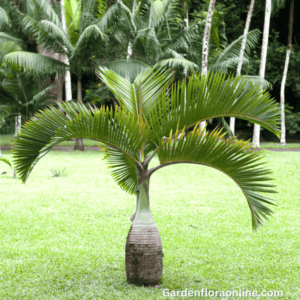Saribus rotundifolius (Fan Palm)
Trunk slender brown, up to 15 m high, 18 cm in diam. Petiole up to 1.8 m long. Leaves palmate, almost perfectly round, up to 1.5 m in diam. Segments numerous, divided only 1/3 distance to petiole, perhaps split more at maturity. Flower-stalk arises in-between the leaves, up to 1.5 m long. Flowers yellow. Fruit spherical, ca. 2 cm in diam., blackish-brown when ripe.
Cultivation: Prefers full sun but tolerates partial shade; young plants thrive in dense shade. Requires fertile, well-drained soil, with no salt tolerance and susceptibility to lethal yellowing. Propagated by seed.
Etymology:
Saribus rotundifolius: The genus name Saribus derives from the vernacular name sariboe used in the Maluku region. The specific epithet rotundifolius translates to “having rounded leaves,” highlighting the nearly circular palmate leaves characteristic of the species.
Livistona rotundifolia: The genus name Livistona named after Patrick Murray, Baron of Livingston (1632–1671), premiere botanist and physician, whose plant collection helped to establish Edinburgh Botanical Gardens in 1670. The specific epithet rotundifolia comes from Latin, with rotundus meaning round and folium meaning leaf, referring to the shape of the palm’s leaves.








